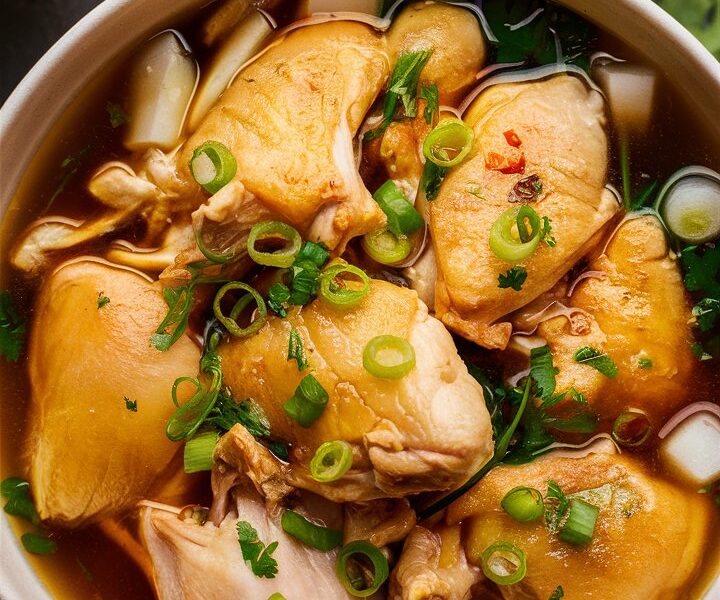There are certain dishes that bring comfort without being heavy, that satisfy without overwhelming, and that speak to tradition while still being adaptable for modern kitchens. Poached Chicken with Ginger Scallion Sauce is one such recipe. At first glance, it looks simple—just tender chicken paired with an aromatic sauce—but within that simplicity lies balance, technique, and soul.
This recipe has its roots in Asian home cooking, especially in Chinese kitchens, where poaching is valued for its ability to preserve the natural sweetness of poultry while keeping the meat juicy. The addition of ginger and scallion transforms the dish into something more than just chicken—it becomes warm, fragrant, and deeply soothing.
Whether you are preparing it for a quiet weeknight meal, a healthy family dinner, or as part of a larger spread, this dish manages to feel special without demanding hours of work.
A Short History of Poached Chicken with Ginger and Scallions
Poaching chicken in water or broth is an ancient cooking method. Cultures around the world use gentle simmering as a way to keep meat moist, but the Chinese version is unique because of the sauce that accompanies it.
In southern China, particularly in Cantonese cuisine, ginger and scallion are considered essential aromatics. They balance each other beautifully—ginger provides warmth and spice, while scallions bring freshness and a mild onion sweetness. Combined with oil and soy sauce, they create a sauce that is savory, aromatic, and versatile.
Over time, this pairing of poached chicken and ginger-scallion sauce spread beyond Chinese households, becoming popular in Asian restaurants and eventually reaching kitchens worldwide. Today, it is recognized as both a comfort food and a healthy option for people who want light, nourishing meals.
Why This Recipe Is So Loved
Cooking is never just about technique—it is also about what a dish makes you feel. Here’s why people keep coming back to this recipe:
- Gentle flavors with depth – It is light, but never bland.
- Healthy cooking method – Poaching avoids excess oil while locking in nutrients.
- Meal-prep friendly – The chicken can be made ahead, stored, and used in salads, noodles, or rice bowls.
- Aromatic punch – The ginger-scallion sauce is what turns this from ordinary poached chicken into a memorable meal.
- Adaptable – Works with chicken drumsticks, thighs, or breasts; the sauce can be adjusted for heat, sweetness, or extra herbs.
Key Ingredients and Their Roles
1. Chicken
Traditionally, drumsticks or thighs are used because they stay juicy during poaching. Breasts can be used for a leaner option, but they need careful timing to avoid dryness.
2. Ginger
Fresh ginger is non-negotiable here. It adds warmth, reduces any “gamey” chicken flavor, and infuses the broth with a soothing aroma.
3. Scallions
Both white and green parts are used. The whites are sautéed for sweetness and depth, while the greens are added at the end for freshness.
4. Soy Sauce and Sugar
These provide balance—umami and mild sweetness. They make the sauce taste complete without overpowering the ginger and scallions.
5. Poaching Liquid
The water used to cook the chicken becomes a flavorful broth. Saving it means you can enrich the sauce or serve it as a light soup alongside the meal.
Step-by-Step Recipe
Step 1: Prepare the Poaching Base
- Bring about 4 cups of water to a boil.
- Add sliced ginger and one whole scallion.
- These aromatics will lightly season the chicken while it cooks.
Step 2: Poach the Chicken
- Gently lower the chicken pieces into the simmering water.
- Once the water returns to a boil, reduce the heat to maintain a gentle simmer.
- Cover and let the chicken cook for about 10 minutes.
Step 3: Rest in Hot Water
- Turn off the heat but keep the lid on.
- Let the chicken rest in the hot liquid for 15 more minutes.
- This ensures the meat is cooked evenly without turning tough.
Step 4: Ice Bath for Perfect Texture
- Transfer chicken to a bowl of ice water for 5 minutes.
- This stops cooking, locks in juiciness, and gives the meat a clean bite.
Step 5: Make the Scallion Oil Sauce
- Heat vegetable oil in a small pan.
- Add chopped scallion whites and sauté until golden.
- Remove and set aside on top of the chicken.
Step 6: Finish the Sauce
- To the remaining oil, add soy sauce, sugar, and half a cup of reserved poaching water.
- Stir and bring to a gentle boil.
- Add minced ginger and the green parts of scallions.
- Simmer briefly, then pour the hot sauce over the shredded chicken.
Serving Suggestions
- With Steamed Jasmine Rice – The most classic pairing.
- Over Noodles – Toss with plain wheat or egg noodles for a quick one-bowl meal.
- With Stir-Fried Vegetables – Bok choy, broccoli, or snap peas add freshness.
- As a Cold Dish – Especially refreshing in summer; serve with cucumber slices and a drizzle of chili oil.
- With Chili Crisp or Pickled Veggies – To add contrast and kick.
Variations and Substitutions
- Boneless Breasts – Shorten poaching time to 5–7 minutes, still resting in hot water.
- Sesame Oil Twist – Add a few drops to the sauce for nutty richness.
- Tamari Instead of Soy Sauce – Perfect for gluten-free diets.
- Spicy Version – Add minced chili peppers to the sauce.
- Herbal Additions – Cilantro or Thai basil can be mixed in for a fresh twist.
Health Benefits of This Dish
- Low in Fat – Poaching requires minimal oil.
- High in Protein – Chicken provides lean, nourishing protein.
- Digestive Aid – Ginger is known to help with digestion and reduce nausea.
- Immune Support – Scallions and ginger both have natural anti-inflammatory properties.
- Hydration and Recovery – The light broth is soothing and replenishing, especially after illness or workouts.
Pro Tips for Perfect Results
- Keep the water at a gentle simmer – boiling hard will toughen the chicken.
- Use fresh aromatics – dried ginger or scallions won’t give the same fragrance.
- Always shock the chicken in ice water – it seals in juiciness.
- Do not microwave leftovers – instead, steam gently to reheat.
- Save the poaching broth – it makes an excellent base for soups or congee.
Storage and Meal Prep
- Refrigerate chicken and sauce separately for up to 3 days.
- Serve cold for a refreshing meal, or reheat chicken by steaming.
- Freeze shredded chicken without sauce for up to 2 months.
Frequently Asked Questions
Q: Can I use chicken breasts instead of thighs?
Yes, just reduce poaching time to prevent dryness.
Q: Is the dish spicy?
No, but you can add chili oil or peppers for heat.
Q: Can I make the sauce ahead of time?
Yes, but it tastes best freshly poured over the chicken.
Q: Why use an ice bath?
It stops the cooking process and keeps the texture firm.
Q: Can I serve it cold?
Absolutely—it’s popular as a chilled summer dish.
Nutritional Information (Per Serving, Approx.)
- Calories: 280
- Protein: 28g
- Fat: 12g
- Carbohydrates: 4g
- Fiber: 1g
- Sodium: 620mg
(Values will vary depending on chicken cut and exact sauce quantities.)
Final Thoughts
Poached Chicken with Ginger Scallion Sauce proves that the simplest dishes often deliver the most comfort. It’s light yet satisfying, aromatic yet not overwhelming, and versatile enough to fit into almost any meal plan.
If you’re looking for a recipe that feels like a warm hug but still keeps things healthy, this is the one. Try it once, and it may become part of your regular cooking routine—something you turn to when you want both nourishment and flavor without fuss.





